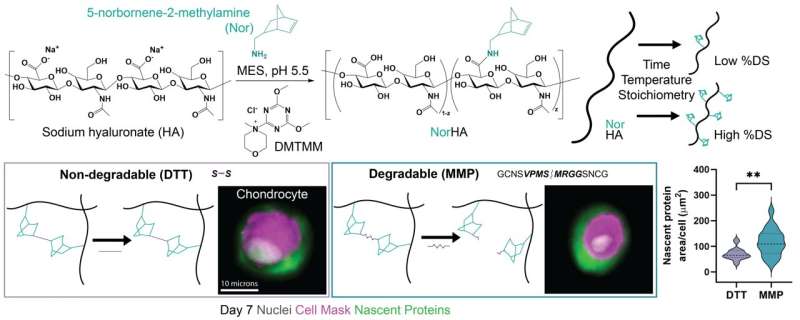This article has been reviewed according to Science X's editorial process and policies. Editors have highlighted the following attributes while ensuring the content's credibility:
fact-checked
trusted source
proofread
Sustainable, more efficient synthesis route of hyaluronic acid polymers for biomedical applications

Hydrogels—polymer networks with high water content—can act as a tissue mimic, providing conditions for a viable culture of embedded cells, with various applications in biomedical engineering such as tissue engineering and regenerative medicine.
Hydrogel networks are often formed by chemically modifying polymers, such as hyaluronic acid, a polymer present in the extracellular matrix surrounding cells, with other molecules, such as norbornene, to form a crosslinked polymer network. Previously published methods coupled norbornene to hyaluronic acid using dimethyl sulfoxide, an organic solvent dangerous to both the environment and the user.
University of Michigan researchers developed a new synthesis route to modify hyaluronic acid with norbornene for use in hydrogels using a water-soluble coupling agent, DMTMM, eliminating the need for harmful organic solvents.
The results of the study are published in Carbohydrate Polymer Technologies and Applications.
"By eliminating the need for organic solvents that are harmful to cells, we have developed a synthesis that is better suited for tissue engineering applications," said Eleanor Plaster, a doctoral student in biomedical engineering and first author of the study.
In addition to increasing the sustainability of hydrogel synthesis, the new synthesis route decreases the reaction and purification time needed to obtain the product. While previous methods using dimethyl sulfoxide required a multistep reaction and several weeks of purification, the DMTMM method occurs in one step and only requires two to three days of purification.
"Our newly developed synthesis method increases the ease of production, allowing labs to make their own polymer more efficiently. It may also allow other groups not previously equipped to synthesize this polymer to perform the reaction themselves instead of outsourcing it," said Plaster.
Using a water-based coupling agent also increases the applicability for use in biomedical applications, as organic solvents are not compatible with cells. The researchers confirmed that cells are viable in norbornene-modified hyaluronic acid synthesized using DMTMM, enabling this material to be used for cell culture for tissue engineering applications.
"The synthesis route that Eleanor has pioneered in our lab not only significantly expedites the research process but also has wide-ranging applicability across various polymers and modifications. I am enthusiastic to witness the future directions she will steer this research towards," said corresponding author Claudia Loebel, assistant professor of materials science and engineering.
More information: Eleanor M. Plaster et al, DMTMM-mediated synthesis of norbornene-modified hyaluronic acid polymers to probe cell-hydrogel interactions, Carbohydrate Polymer Technologies and Applications (2023). DOI: 10.1016/j.carpta.2023.100360
Provided by University of Michigan College of Engineering





















